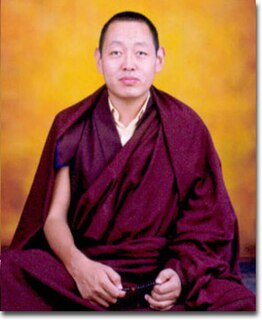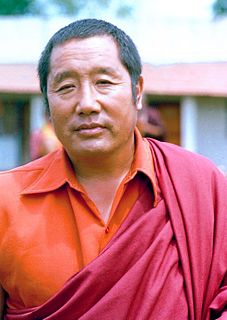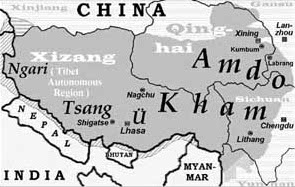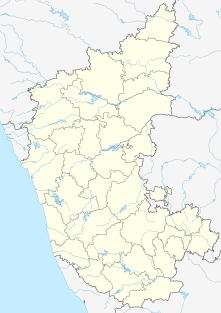
Dilgo Khyentse Rinpoche was a Vajrayana master, scholar, poet, teacher, and head of the Nyingma school of Tibetan Buddhism from 1987 to 1991.

Jamyang Khyentse Wangpo, also known by his tertön title, Pema Ösel Dongak Lingpa, was a renowned teacher, scholar and tertön of 19th-century Tibet. He was a leading figure in the Rimé movement.

Dzongsar Jamyang Khyentse Rinpoche, also known as Khyentse Norbu, is a Tibetan/Bhutanese lama, filmmaker, and writer. His four major films are The Cup (1999), Travellers and Magicians (2003), Vara: A Blessing (2013) and, most recently, Hema Hema: Sing Me a Song While I Wait (2017). He is the author of the books What Makes You Not a Buddhist ; Not for Happiness: A Guide to the So-Called Preliminary Practices ; The Guru Drinks Bourbon ; and Best Foot Forward: A Pilgrim's Guide to the Sacred Sites of the Buddha and his other books like Teachings on Ngöndro, Parting from the Four Attachments, What to do at India's Buddhist Holy Sites, Buddha Nature, Introduction to the Middle Way are also available through the Siddharthas Intent website.
Dzongsar Khyentse Chökyi Lodrö was a Tibetan lama, a master of many lineages, and a teacher of many of the major figures in 20th-century Tibetan Buddhism. Though he died in 1959 in Sikkim, and is not so well known in the West; he was a major proponent of the Rimé movement within Tibetan Buddhism, and had a profound influence on many of the Tibetan lamas teaching today.

Chagdud Tulku was a Tibetan teacher of the Nyingma school of Vajrayana Tibetan Buddhism. He was known and respected in the West for his teachings, his melodic chanting voice, his artistry as a sculptor and painter, and his skill as a physician. He acted as a spiritual guide for thousands of students worldwide. He was the sixteenth tülku of the Chagdud line.
Chatral Sangye Dorje Rinpoche was a Dzogchen master and a reclusive yogi known for his great realization and strict discipline. Rinpoche was one of the few living disciples of Khenpo Ngawang Pelzang and was widely regarded as one of the most highly realized Dzogchen yogis. In addition to his relationship with Khenpo Ngagchung, Chatral Sangye Dorje also studied with some of the last century's most renowned masters, including Dudjom Jigdral Yeshe Dorje, Dzongsar Khyentse Chökyi Lodrö, and the famed Kunzang Dekyong Wangmo. Rinpoche was one of the primary lineage holders of the Longchen Nyingthig, and in particular the lineage that descends through Jigme Lingpa's heart son Jigme Gyalwe Nyugu and then on to Patrul Rinpoche.
Khentrul Lodrö Thayé Rinpoche is the abbot of Mardo Tashi Choling in Eastern Tibet. He established a retreat center there. He created the shedra, a formal Buddhist monastic teaching, under the direct guidance of his teacher Khenpo Jigmed Phuntsok Rinpoche. He directs the education and spiritual practice of three hundred monks, seventy advanced-degree candidates, sixty children, and twenty full-time retreatants.

Khenpo Sherab Sangpo

Patrul Rinpoche (1808–1887) was a prominent teacher and author of the Nyingma school of Tibetan Buddhism.

Gonpo Tseten Rinpoche (1906–1991) was a Dzogchen master, author, painter, sculptor, and teacher of the Nyingma school of Tibetan Buddhism.
The Second Beru Khyentse (1947–), born Thupten Sherap is a lineage holder of the Karma Kagyu school of Tibetan Buddhism and the third reincarnation of Jamyang Khyentse Wangpo (1820–1892).
Orgyen Tobgyal Rinpoche, also called Tulku Ugyen Topgyal, is a Tibetan Buddhist lama who was born in Kham in Eastern Tibet in 1951, living in exile in India.

According to Tibetan Buddhism the IXth Minling Khenchen Rinpoche is the successive reincarnation of the Minling Kenrab lineage, co-administrator of Mindrolling Monastery and Head Abbot In-Charge of Ngagyur Nyingma College in India, Vajrayana master, scholar, and teacher.
Taklung Tsetrul Rinpoche was a Tibetan lama and the Supreme Head of the Nyingma School of Tibetan Buddhism. He received the highest Dzogchen teachings from Polu Khenpo Dorje, a direct disciple of Khenpo Ngakchung.
"Kyabje Taklung Tsetrul Rinpoche, throneholder of the Dorje Drak monastery, accepted the position of the Supreme Head of Nyingmapa lineage, the “Old Translation Tradition” in Tibetan Buddhism. He is following Kyabje Dudjom Rinpoche, Kyabje Dilgo Khyentse Rinpoche, Kyabje Drubwang Pema Norbu Rinpoche, Kyabje Mindroling Trichen Rinpoche, and then finally Kyabje Trulshik Rinpoche, who died late last year."
Tsoknyi Rinpoche or Ngawang Tsoknyi Gyatso is a Nepalese Tibetan Buddhist teacher and author, and the founder of the Pundarika Foundation. He is the third Tsoknyi Rinpoche, having been recognized by the 16th Karmapa as the reincarnation of Drubwang Tsoknyi Rinpoche. He is a tulku of the Drukpa Kagyü and Nyingma traditions and the holder of the Ratna Lingpa and Tsoknyi lineages.
Lama Chime Tulku Rinpoche is a Tibetan Buddhist, Tulku and Dharma teacher. Chime Rinpoche was born in 1941 in Kham, Tibet. In 1959, due to the occupation of Tibet, he was forced to flee to India via Bhutan into exile. Gaining British citizenship in 1965. He taught extensively throughout Europe and established Marpa House, the first Tibetan Buddhist Centre in England. His students include American author and Buddhist nun Pema Chödrön and musicians Mary Hopkin, David Bowie and Tony Visconti.

Phakchok Rinpoche is a teacher of the Nyingma lineage and chief lineage holder of the Taklung Kagyu lineage of Tibetan Buddhism. He is Vajra Master of Ka-Nying Shedrup Ling monastery, abbot of several monasteries in Nepal, and assists monasteries and practice centers in Tibet. In addition, he serves as Director of the Chokgyur Lingpa Foundation, a nonprofit organization engaged in a wide range of humanitarian projects.
Tsikey Chokling Rinpoche is a teacher, writer, religious ritual master, and meditation master of the Nyingma school of Tibetan Buddhism.

















